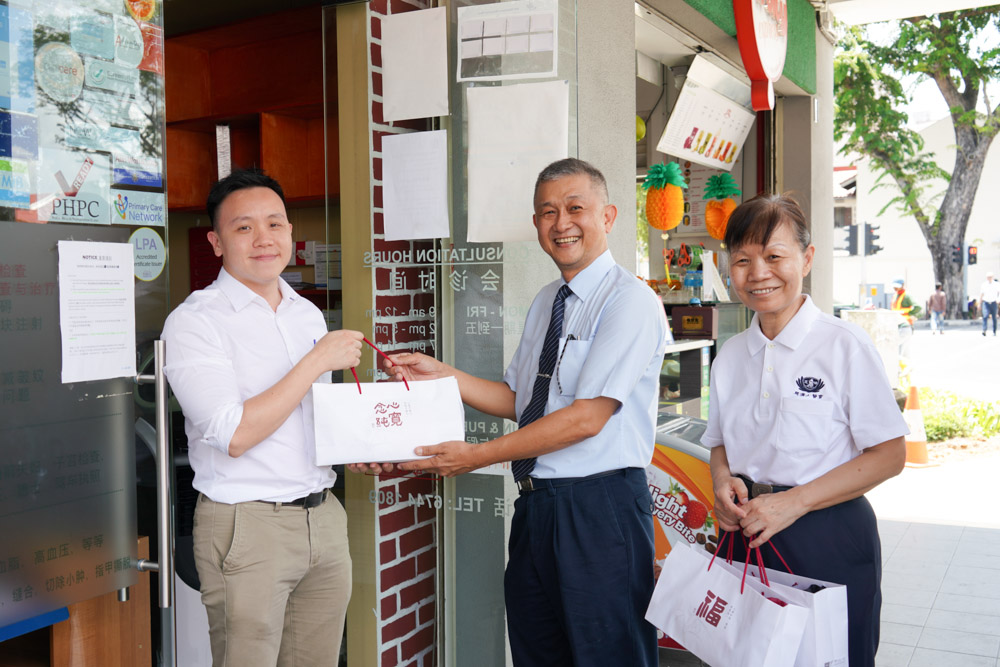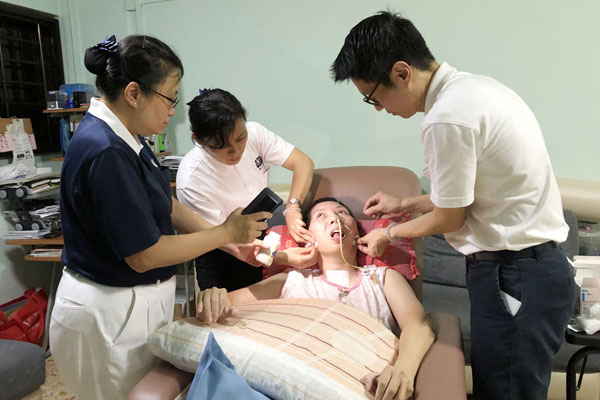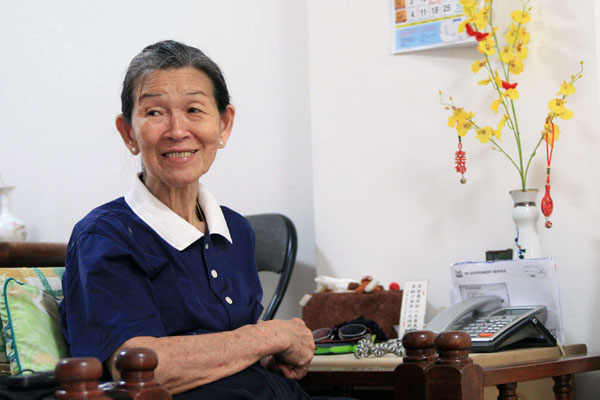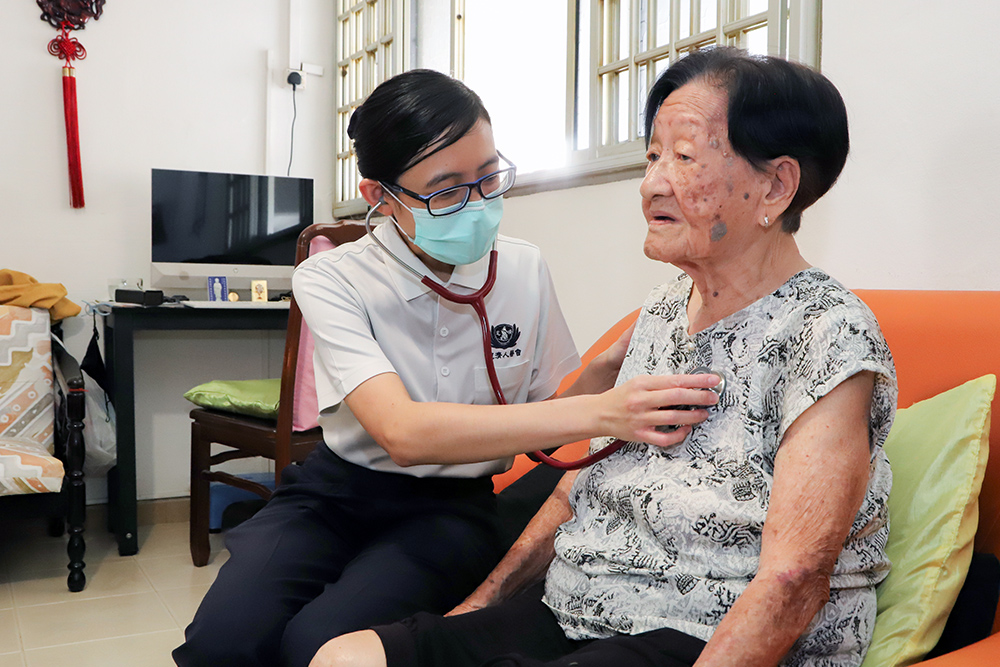 Home care doctor Ho Xin Qin (left) treating a Tzu Chi care recipient who is home-bound. (Photo by Chua Teong Seng)
Home care doctor Ho Xin Qin (left) treating a Tzu Chi care recipient who is home-bound. (Photo by Chua Teong Seng)
"This pile (of medicines) was given by the hospital. I don't remember what they are for, and they were never used."
During the home care visit, Madam Tan's daughter asked Dr Ho Xin Qin about the medicines and nursing supplies she brought home from the hospital.
The daughter took out a device with a small yellow ball from amongst the pile and said, "My mother used to blow this. I don't know what it is for."
Dr Ho was startled and said: "This is for training lung capacity. It is meant for inhalation and not exhalation."
Having provided home care services to patients in the community, Dr Ho discovered that many caregivers face challenges when caring for patients at home. Family members often take out a bag of medicines or nursing supplies like Madam Tan's daughter, as they do not know the proper usage. Dr Ho patiently explained: "The hospital which dispenses these items would teach about the proper usage, but it is like teaching students, you can hardly expect students to learn and remember a lot in one lesson."
During home care visits, the team often encounters patients taking out a bag of medicines or nursing supplies and not knowing how to use them correctly. For example, a medical device to train lung capacity through inhalation was wrongly used for exhalation. (Photo by Chan May Ching)
There are patients who brought home hospital prescribed medicines without understanding the proper administration. She said: "At times, a new batch of medicines would be mixed up with the previous batch. Some patients have been discharged for several days but have yet to start taking the newly prescribed medicines. And their family would give them the previous batch of medicines with the changes made by the hospital not followed."
"It's not that the patients refuse to take medicine. They are really 'blur' (can't distinguish the old and the new medicine)."
Dr Ho also shared: "Although the pharmacists in the hospital will explain, some family members just don’t get it. Another scenario is the person who accompanied the patient to see the doctor is A, but the person who lives with the patient is B. In the end, the wrong message was conveyed. And sometimes, the domestic helper does not understand it well. This is quite common."
Dr Ho, who once worked in a hospital's emergency department, realised that often, it is not that the caregiver is making a fuss and sending patients to the hospital at every turn. The caregivers have been facing caregiving problems alone for a long time. They could not find professional help when encountering problems and accumulated a lot of mental stress. So, when the patient recover after being admitted to the hospital, sending the patient to the hospital became the only way out when the caregiver panicked.
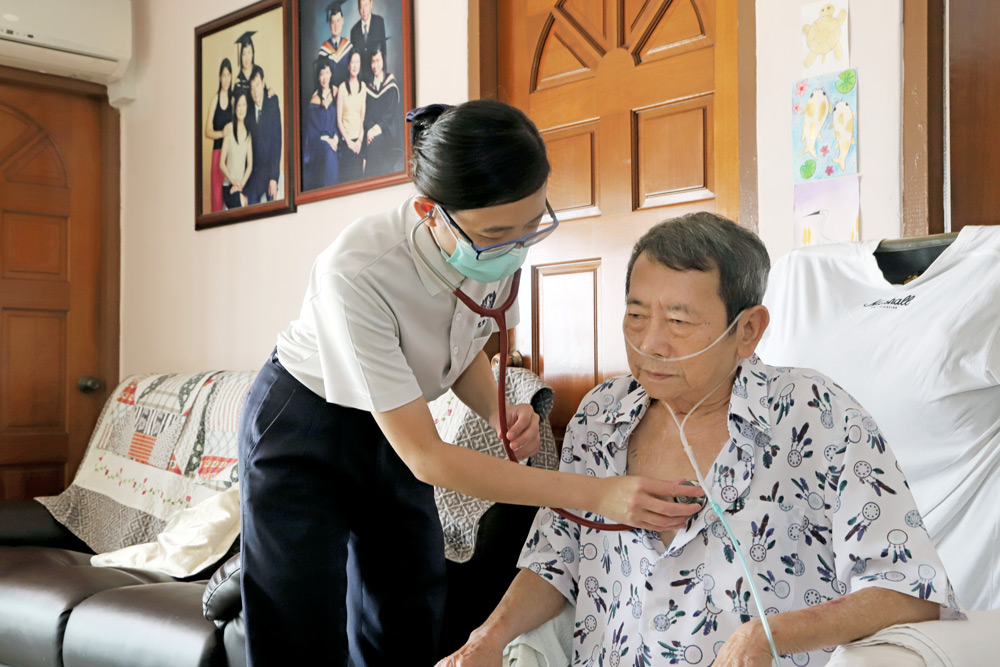 (Photo by Chua Teong Seng)
(Photo by Chua Teong Seng)
She shared that at the peak of the COVID-19 pandemic, the mother of a friend who is a doctor was diagnosed with end-stage Parkinson's disease and decided not to be hospitalised. However, when her lungs were infected to the point of suffocation, the doctor friend became helpless and sought for Dr Ho’s help. Eventually, Dr Ho arranged for oxygen tanks and medicine to be delivered from her clinic.
Dr Ho lamented that even trained medical professionals can have moments of panic and helplessness when caring for family members, let alone ordinary people.
Dr Ho, who also serves as a resident doctor at Lakeside Family Medicine Clinic, pointed out that in recent years, the medical community has also become aware of the need to offer a good transition to the community after hospital discharge, hence the establishment of a referral service called "Hospital to Home". This home care service targets seniors with stable but chronic conditions, which require more complex caregiving and associated training. The range of the service may vary from imparting correct knowledge and skills of caring for patients to daily medicine preparation.
As Singapore progresses into an ageing society, it has become the norm for children to accompany their elderly parents to the hospital. They can rush from department to department, such as cardiology, urology, pulmonology, neurology, ophthalmology, otolaryngology etc. Some patients have so many appointments that it will unnerve you," Dr Ho said.
Home care service eliminates the need for family members to travel back and forth to the hospital and saves time waiting in line for medical treatment and payment. As a result, patients receive better quality care, including a lower readmission rate, significantly reducing the burden on family members, hospitals and society.
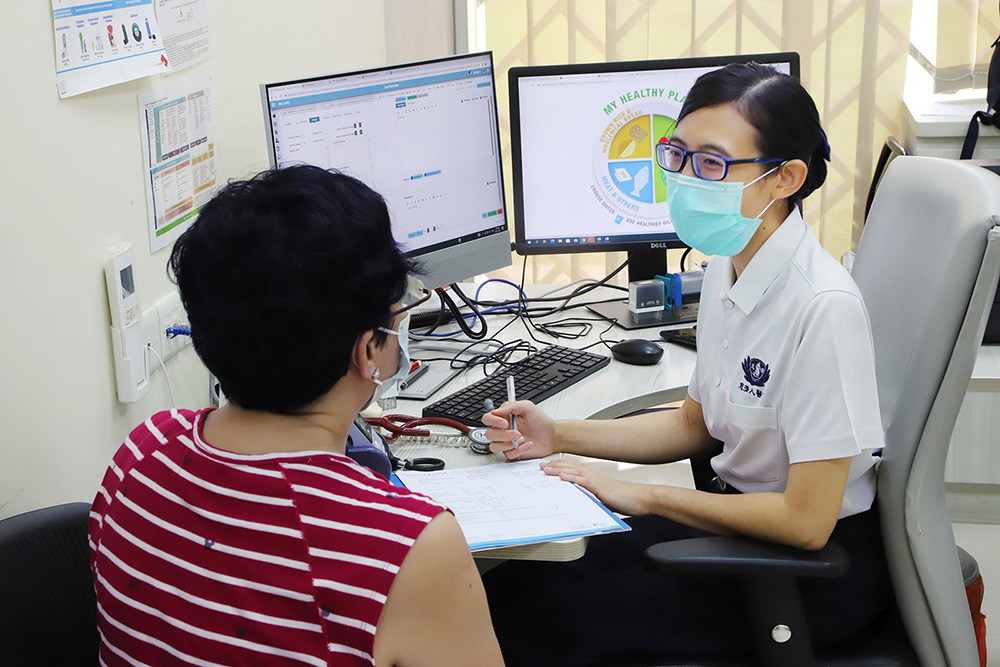 Dr Ho Xin Qin (right) also serves as a resident doctor at Lakeside Family Medicine Clinic. (Photo by Chua Teong Seng)
Dr Ho Xin Qin (right) also serves as a resident doctor at Lakeside Family Medicine Clinic. (Photo by Chua Teong Seng)
Dr Ho gave an example of how some patients benefit from home care services. For those with chronic diseases who have finished their medicine, the home care team can prescribe the same or similar prescriptions after diagnosis. The disadvantage is that the team cannot conduct in-depth examinations without the more complex medical instruments.
She further explained that some elderly patients with eye diseases might be frail or bedridden. Their immediate concern is not vision but rather the frequent visits to the hospital, which can be a great burden to the patients and caregivers.
Dr Ho bemoaned that modern medical advancements always aim to treat every disease, which is also the ethical expectation of doctors. But Dr Ho reflected: "As I get older and in my eighties, is it really the best for me to spend so much effort and time to get all my organs in good condition?"
Dr Ho once encountered a patient who was over 90 years old and had to be admitted for endoscopy, which may uncover a cancerous tumour. However, that elderly quizzed: "I am already 95 years old. Even if it is cancer, would I want to resort to invasive treatment?"
Patients who understand the causes and consequences may consider giving up the appointment.
Therefore, the doctor's explanation is critical. It helps the patient and family members to determine their desired treatment. Therefore, the home care team does not only help with checking the medicines and nursing supplies but also "checking appointments" to help patients evaluate the options rationally.
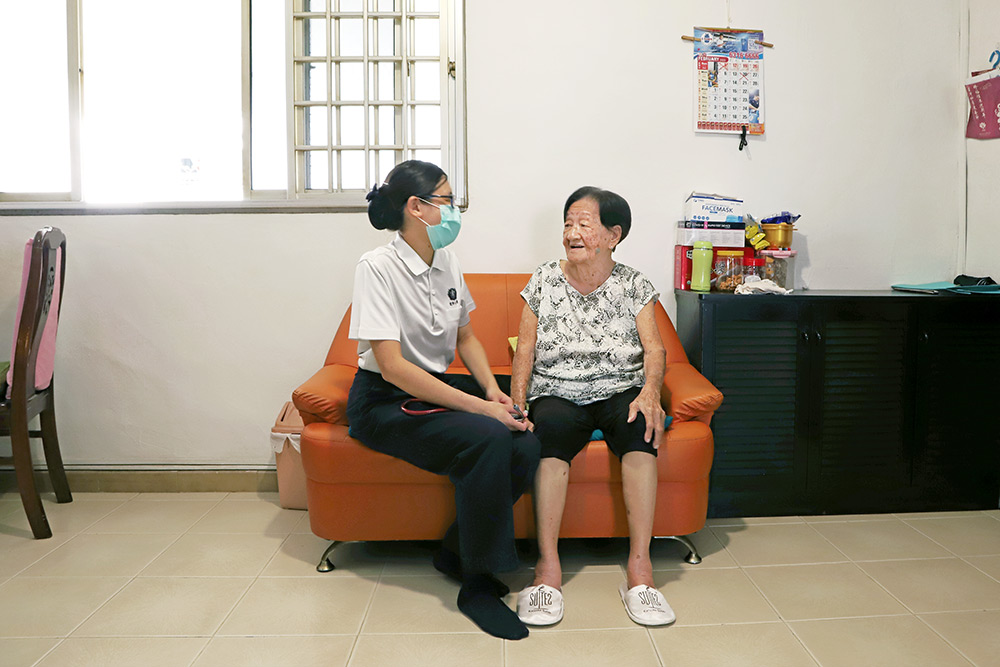 Chatting and laughing with patients, Dr Ho Xin Qin (left) said that the connection between home care team and patients is “barrier-free”. (Photo by Chua Teong Seng)
Chatting and laughing with patients, Dr Ho Xin Qin (left) said that the connection between home care team and patients is “barrier-free”. (Photo by Chua Teong Seng)
Compared to providing medical services in a clinic, Dr Ho opined that the contact between doctors and patients in a home care setting is closer.
"When you step into the patient's home, the patient becomes a person with a family. When you are in his living environment, you cannot help but empathise and think hard about how to truly help the patient," Dr Ho said.
Seeing the lives of patients after discharge, she realised that daily life is more important than treating the disease.
She said: "It is easier to empathise with the patient upon seeing his living condition. If the patient cannot even take care of his hygiene, it may be too demanding for the patient to divert so much energy into medical care. In such instances, we need to help him become more hygienic first."
Home care service allows more time and offers better conditions to understand the physical, mental and emotional needs of the patients and their families. This is entirely different from Dr Ho's previous work in the emergency department, where people are always racing with time. And perhaps more importantly, our empathy is "putting people first and treating diseases as teachers".
Dr Ho recalled that when she went overseas to participate in medical missions in remote areas, the queues for medical treatment were always endless. The work is of immense pressure, but she once witnessed a doctor who would stand up and bow with his palms together after treating a patient and then continue to treat the next patient.
She recalled: "The doctor putting his palms together and bowing only lasted a few seconds, which did not hinder the speed and accuracy of the doctor's treatment. However, the people around him were shocked and felt his sincere 'gratitude, respect and love'."

